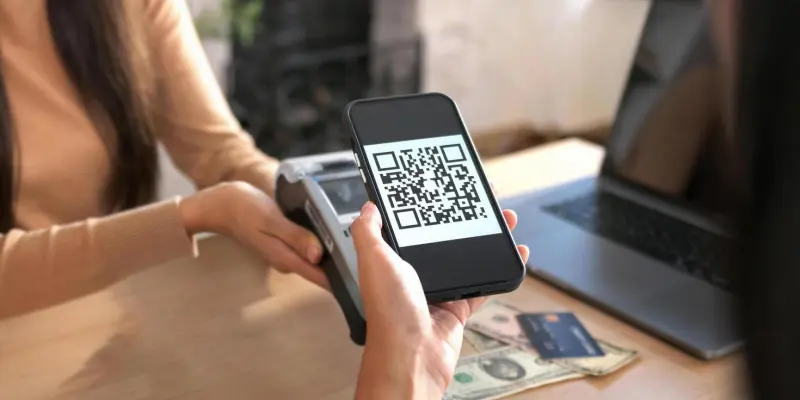The digital realm continues to redefine how we conduct financial transactions in an increasingly contactless world. QR code payments, a technology that has gained significant traction over the past few years, stand at the forefront of this transformation. Initially popularized in the automotive industry, QR codes have now penetrated various sectors, offering a seamless, efficient, and secure method of payment. This surge is not only a response to technological advancements but also reflects a shift in consumer behavior toward convenient, digital-first solutions. With QR code payments rapidly evolving, the financial landscape is on the brink of a new era characterized by swift and secure transactions.
Evolution and Expansion of QR Code Payments
Technological Advancements
One of the significant drivers behind the proliferation of QR code payments is technological advancement. As smartphones become more prevalent and internet speeds continue to improve, QR code payments are naturally positioned to thrive. This technology, which utilizes quick response codes to facilitate payments, offers a convenient alternative to traditional payment methods. The simplicity of QR codes allows them to be easily integrated into existing point-of-sale systems, making them an attractive option for a wide range of businesses, from small retailers to large corporations. Moreover, the global emphasis on digitization has opened new frontiers for QR code technology, encouraging businesses to adopt this payment method and thus expanding its reach.
Market Dynamics and Growth Drivers
The market for QR code payments has experienced remarkable growth, as reflected by its estimated compound annual growth rate (CAGR) of 16.1%. This upward trajectory highlights the strong demand for touchless transaction solutions, especially in contexts where health and safety are priorities. The flexibility of QR codes to be used in both offline and online environments further cements their role as a versatile payment method. Emerging markets, characterized by increasing smartphone penetration and expanding middle-class populations, present significant opportunities for QR code payment providers. The demographic shift towards a younger, more digitally aware population drives the adoption of such payment systems, fostering an environment conducive to the widespread use of QR codes for financial transactions.
Overcoming Challenges and Security Concerns
Addressing Security Issues
Despite the evident benefits and rapid adoption of QR code payments, security remains a crucial concern that could impede further growth. The inherent risk of data breaches and fraudulent activities poses significant challenges for service providers and users alike. To ensure the continued growth of QR code payments, it is imperative for companies to prioritize cybersecurity measures. This involves implementing robust encryption protocols, conducting regular security audits, and ensuring consumer awareness about security practices. By doing so, companies can build trust among users, mitigating potential apprehensions related to digital payment systems.
Regulatory and Compliance Challenges
As QR code payments become more ubiquitous, regulatory frameworks will need to evolve to address new challenges related to data protection and consumer rights. Different regions may have varying regulations, which can complicate the deployment of a standardized global system. Service providers will need to navigate this complex landscape by adhering to local laws while maintaining consistency in service delivery across borders. Additionally, regulators must strike a balance between fostering innovation in the financial sector and ensuring adequate consumer protection. Achieving this balance requires ongoing collaboration between technological firms, financial institutions, and regulatory bodies to create a secure yet conducive environment for the continued evolution of QR code payments.
Competitive Landscape and Strategic Collaborations
Key Industry Players
Several key industry players are spearheading innovations in QR code payments, contributing to the dynamic competitive landscape. Companies such as UnionPay International, PayPal, Google, and Alibaba.com are at the forefront, leveraging their resources to expand market presence and drive technological advancements. These corporations have established themselves as early adopters who understand the nuanced demands of the modern consumer. Through strategic investments in research and development, they continue to pioneer solutions that enhance the adaptability and efficiency of QR code payments. By fulfilling these ambitions, they not only solidify their positions within the industry but also pave the way for further innovation.
Collaborations and Partnerships
In an effort to expand their reach and offer enhanced services, major companies are increasingly engaging in strategic partnerships and collaborations. Such alliances allow them to tap into each other’s strengths, creating synergies that contribute to a more comprehensive service offering. For instance, partnerships between tech giants and financial service providers can lead to the development of integrated solutions that cater to a broader audience. These collaborations often result in the pooling of resources and expertise, fostering an environment of innovation while accelerating market penetration. As a result, the collaborative approach serves as a catalyst for the evolution and expansion of QR code payment systems.
Future Outlook and Prospects
In today’s increasingly contactless world, the digital sphere is reshaping the way we handle financial transactions. At the helm of this shift is QR code payment technology, which has seen a significant rise in adoption over recent years. Initially introduced by the automotive industry, QR codes have swiftly spread across various sectors, becoming a go-to solution for those seeking seamless, efficient, and secure payment methods. This trend isn’t merely a reflection of technological progress; it also highlights a significant change in consumer behavior, as people increasingly gravitate toward convenient, digital-first methods for managing transactions. As QR code payments continue evolving, the financial landscape is poised to enter a new era where transactions are not just quick, but also highly secure. The widespread embrace of QR codes signifies a major transformation, underscoring both the adaptability of modern technology and the evolving preferences of consumers in a digital-focused world.

